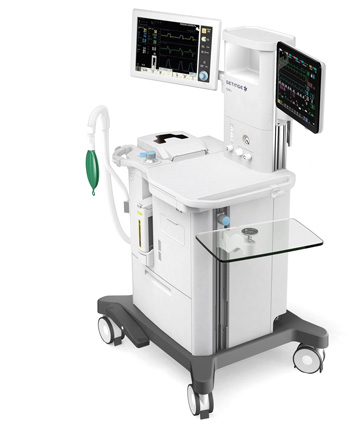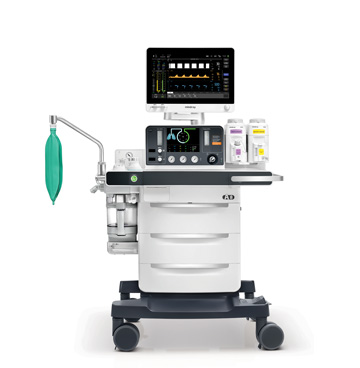• Ventilation modes. Units with multiple ventilation modes allow anesthesia providers to administer safer anesthetic care. These additional modes — which providers didn’t use as much, or ever, before at outpatient centers
— not only enable them to deliver safer care, but also make surgery far easier on the patient while increasing efficiency for the center. For example, I prefer to work with machines that can manage two vaporizers so I can administer
either desflurane or sevoflurane. Because efficiency is an issue both clinically and financially at centers, I prefer to administer desflurane because it results in faster emergence and less need for oral airways in the PACU. I also want
to be able to administer sevoflurane to certain patients such as children, because the pungent smell of desflurane makes it a less than ideal choice during inhalation inductions.
Anesthesia providers work on a continuum at ASCs, flowing with a patient from pre-op to the OR and to the PACU. We might need to be more conservative about how we drop patients off in the PACU than we would be in a hospital setting where there
is typically a float provider available for issues such as airway obstruction. Having a desflurane vaporizer available is optimal because patients will wake up much faster, which prevents providers from taking a groggy patient with an
oral airway into the PACU.
There are several modes of ventilation available on current anesthesia machines that offer varying degrees of functionality: volume-controlled ventilation (VCV); pressure support ventilation (PSV); synchronized intermittent mandatory ventilation
(SIMV); pressure-controlled ventilation (PCV); and pressure control with volume guarantee (PCV-VG). When evaluating anesthesia machines for your surgery center, you want to find the middle ground. To some degree, your choice should be
tailored to your specific surgery center. If your facility specializes in GI, your care team will barely use a ventilator, let alone advanced modes. In this setting, VCV and PCV, the most basic modes, would be appropriate. But the patient
populations at most of today’s surgery centers will require more than these basic, one-size-fits-all modes. If you’re a multispecialty surgery center performing complex surgeries with inhalational anesthesia, the enhanced
modes are especially useful.
• Monitoring. Every anesthesia provider needs the basic and accurate monitoring of oxygen concentration, gas concentration and end-tidal CO2. Many anesthesia machines have these modalities built-in, while others require the use
of standalone monitors. For example, some machines have a separate gas analyzer attached to the oxygen monitor. Machines with integrated monitoring modalities are more expensive, but are the more user-friendly and clinically efficient
option.
• EMR integration. As more ASCs transition away from paper charts, newer anesthesia machines are compatible with EMR platforms. EMR integration is an important consideration when upgrading anesthesia machines, monitors or when
outfitting a new ASC. When the monitor brand is different from the make of the anesthesia machine, EMR integration can be difficult. Some machines require an adapter (one example is called a capsule) that acts as a data networking intermediary
between the machine, the anesthesia monitor and the EMR. If your machine is EMR-capable but you can’t get it to automatically feed data to the EMR, your providers might still need to enter the information manually. This isn’t
optimal when there are many solutions that allow for automatic data capture.
• Compact designs. Floor space at surgery centers is valuable real estate, so anesthesia machine manufacturers are offering versatile units with advanced capabilities in smaller footprint. Still, you might need to pull back on
some options if there isn’t a lot of room to move around the sterile field. Every anesthesia provider would love a machine with a wraparound workstation and all kinds of drawers and storage options, but you might need to forgo these
bells and whistles if space is a major concern in your ORs.
• Intuitive controls. I’ve used machines with touchscreen controls that were difficult to navigate and at times unresponsive. I’d repeatedly push on the screen to switch the ventilation mode, but it wouldn’t work.
That’s not just a time-wasting annoyance, it can also present a patient safety issue. The good news is that many newer machines have user-friendly touchscreens with great functionality that make operating them a breeze.
The key to purchasing the best anesthesia machine for your surgery center is to involve your anesthesia providers in the purchasing process from the start. Let them trial machines before you buy them, so they can tell you which features would
allow them to provide safe and efficient care. OSM
.svg?sfvrsn=be606e78_3)




.svg?sfvrsn=56b2f850_5)